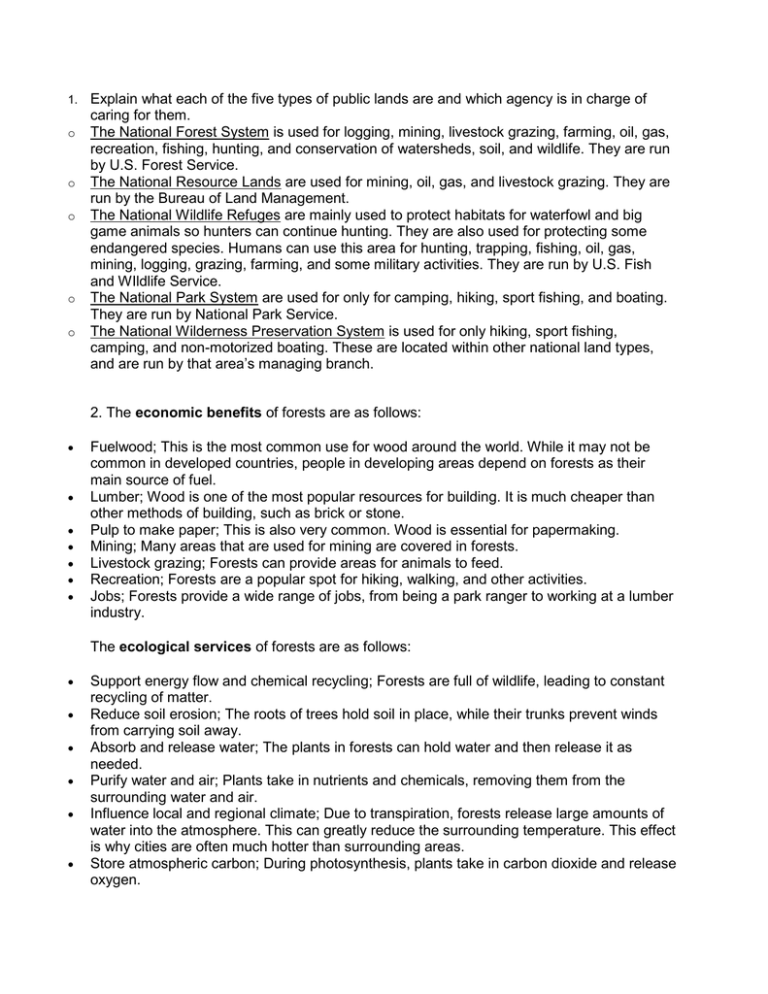Explain what each of the five types of public lands are and which
advertisement

1. o o o o o Explain what each of the five types of public lands are and which agency is in charge of caring for them. The National Forest System is used for logging, mining, livestock grazing, farming, oil, gas, recreation, fishing, hunting, and conservation of watersheds, soil, and wildlife. They are run by U.S. Forest Service. The National Resource Lands are used for mining, oil, gas, and livestock grazing. They are run by the Bureau of Land Management. The National Wildlife Refuges are mainly used to protect habitats for waterfowl and big game animals so hunters can continue hunting. They are also used for protecting some endangered species. Humans can use this area for hunting, trapping, fishing, oil, gas, mining, logging, grazing, farming, and some military activities. They are run by U.S. Fish and WIldlife Service. The National Park System are used for only for camping, hiking, sport fishing, and boating. They are run by National Park Service. The National Wilderness Preservation System is used for only hiking, sport fishing, camping, and non-motorized boating. These are located within other national land types, and are run by that area’s managing branch. 2. The economic benefits of forests are as follows: Fuelwood; This is the most common use for wood around the world. While it may not be common in developed countries, people in developing areas depend on forests as their main source of fuel. Lumber; Wood is one of the most popular resources for building. It is much cheaper than other methods of building, such as brick or stone. Pulp to make paper; This is also very common. Wood is essential for papermaking. Mining; Many areas that are used for mining are covered in forests. Livestock grazing; Forests can provide areas for animals to feed. Recreation; Forests are a popular spot for hiking, walking, and other activities. Jobs; Forests provide a wide range of jobs, from being a park ranger to working at a lumber industry. The ecological services of forests are as follows: Support energy flow and chemical recycling; Forests are full of wildlife, leading to constant recycling of matter. Reduce soil erosion; The roots of trees hold soil in place, while their trunks prevent winds from carrying soil away. Absorb and release water; The plants in forests can hold water and then release it as needed. Purify water and air; Plants take in nutrients and chemicals, removing them from the surrounding water and air. Influence local and regional climate; Due to transpiration, forests release large amounts of water into the atmosphere. This can greatly reduce the surrounding temperature. This effect is why cities are often much hotter than surrounding areas. Store atmospheric carbon; During photosynthesis, plants take in carbon dioxide and release oxygen. Provide numerous wildlife habitats; Forests are a vital habitat for a myriad of species. 3. An old-growth forest is an uncut or regenerated forest that hasn't been seriously disturbed by human activities it natural disasters for at least several hundreds of years. They're storehouses of biodiversity because they provide ecological niches for multiple species. Second-growth is a stand of trees resulting from secondary ecological succession, they develop after the trees in an area have been removed. A tree plantation or tree farm is a managed tract with uniformly aged trees of one species that are harvested by clear cutting as soon as they become commercially valuable then replanted and cut again. 4. Even-aged management is management in which trees, sometimes of a single species in a given stand, are maintained at about the same age and size and are harvested all at once. Cons Pros Allows almost complete control over stand Higher potential for damaging erosion to establishment occur Less root competition in the regenerated stand Usually less biologically diverse, particularly young stands Due to it being a more simple practice, it’s May be higher risk of disease, insect easier to maintain problems, and wildfire Uneven-aged management is management in which trees of different species in a given stand are maintained at many ages and sized to permit continuous natural regeneration. Cons Pros Diverse structure, with small, medium and large It’s more complex and difficult to achieve trees providing a multi-layered canopy. This and maintain. Some management costs are forest structure provides needed or preferred higher because more detailed information habitat for many plant and wildlife species. about the stand is required. There is continuous cover on a site, reducing More challenging to to achieve a balanced, problems with erosion and excessive runoff sustained yield of forest products after heavy rains More biologically diverse Depending on size of cuts and species, may be more root competition in the residual stand 5. The following are the five different methods of tree harvesting listed in order of most sustainable to least sustainable with their respective advantages and disadvantages. 1. selective cutting: Intermediate-aged or mature trees in an uneven-aged forest are cut singly or in a small groups. 1. 2. 2. 1. 2. 3. 1. 2. 4. 1. 2. 5. 1. 2. Advantages: Selective cutting reduces crowding, encourages growth of younger trees, maintains an uneven-aged stand of trees of different species, and allows regeneration of surrounding trees. Disadvantages: For every large tree cut down, 16 or 17 other trees are damaged or pulled down because of a network of vines that connects the trees. This forest reduction can make soil warmer and drier and makes soil erosion more likely. shelterwood cutting: Removes all mature trees in an area in order to allow some species which grow best in full or moderate sunlight to thrive in clearings. Advantages: Allows certain, smaller tree species, which require full sunlight, to be able to grow in clearings. Disadvantages: Tree removal can increase soil erosion and reduce biodiversity. seed-tree cutting: Loggers harvest nearly all of a strand’s trees in one cutting but leave a few uniformly distributed seed-producing trees to regenerate the strand. Advantages: leaves seed-producing trees to regenerate the strand. Disadvantages: Removal of other trees will damage root system and therefore other trees not intended to be cut. clear cutting: removes all the trees from an area in a single cutting. Advantages: High timber yield, best way to harvest tree plantations, maximum economic return in a short time. Disadvantages: Reduced biodiversity, disrupts ecosystem processes, increased soil erosion, eliminates most recreational value for several decades. strip cutting: Clear cutting a strip of trees along the contour of the land, with the corridor narrow enough to allow natural regeneration within a few years. After regeneration, loggers cut another strip above the first, and so on. Advantages: Only removing certain trees allows for faster regrowth and reduces loss of biodiversity. Disadvantages: Removing trees destroys root systems of other trees and soil quality. 6. Benito! 7). Factors that promote timber harvesting in U.S. national forests are timber companies pressuring congress to increase timber harvesting, and the Congress also passed a law that allows the forest service to keep most of the money it makes on timber sales. This makes timber cutting extremely important to the Forest Service in order to increase its budget. Timber harvesting in U.S. national forests usually loses money for the U.S. citizens who own the forests because revenue from timber sales does not cover the costs of road building, timber sale preparation, administration, and other overhead causes. ALSO, LAND IS LEASED TO HARVESTING COMPANIES AT RATES LOWER THAN FAIR MARKET VALUE. Due to this, tax payers generally lose money from this practice. 8.) The five basic causes of tropical deforestation and degradation are: Not valuing ecological services Exports Government Policies Poverty Population Growth Government policies including things like logging cause forest degradation, starting with a logging road being cut and only getting worse. Loggers use high grading logging practices (cutting down the best and oldest timber). In the act of removing these trees other, younger trees with shallow root systems are knocked down as well. After all of the usable timber has been removed and sold degradation continues when loggers' land is transformed into farmland where ranchers ruin the land for the future by overgrazing it. 9). The importance of roads to society and the environmental damage done by constructing them are both undeniable. Some of the negative effects on a forest after a road has been made through it include habitat fragmentation, increased sedimentation, degraded water quality, loss of soil productivity and a loss of biodiversity. 10. Habitat corridors are areas of habitat that connect reserves or wildlife populations that were separated due to human activities or structures. They are helpful to maintaining biodiversity because they permit the migration of individuals and populations when environmental conditions deteriorate or animals have to seasonally migrate. Species may also have to migrate due to shift in climate change. Wilderness is “undeveloped land affected primarily by the forces of nature, where man is a visitor and does not remain” - U.S. wilderness Act of 1964. People can only hike, camp, enjoy pure nature. All resource extraction for economic purpose is prohibited. Anything else environmentally degrading is also prohibited. 11. a. Restoration is the process of returning a degraded habitat or ecosystem to a state that is similar to its natural state. However, a lack of knowledge about the original state, and/or changes in uncontrollable factors such as climate may make it impossible to completely restore an area, so the area will only be restored to the best of our ability. b. Rehabilitating a degraded ecosystem is attempting to cleanse the ecosystem, removing pollutants and replanting cleared areas such as landfills and clear-cut forests. This turns the ecosystem back into a useful system. c. Remediation is cleaning up contaminants from an area in order to redevelop that site. This turns a former human development, such as an abandoned factory, into a more useful development, such as a sports field. d. Replacement is the act of replacing a degraded ecosystem with a different type of ecosystem. e. Artificial ecosystems are ecosystems that are created by humans.







